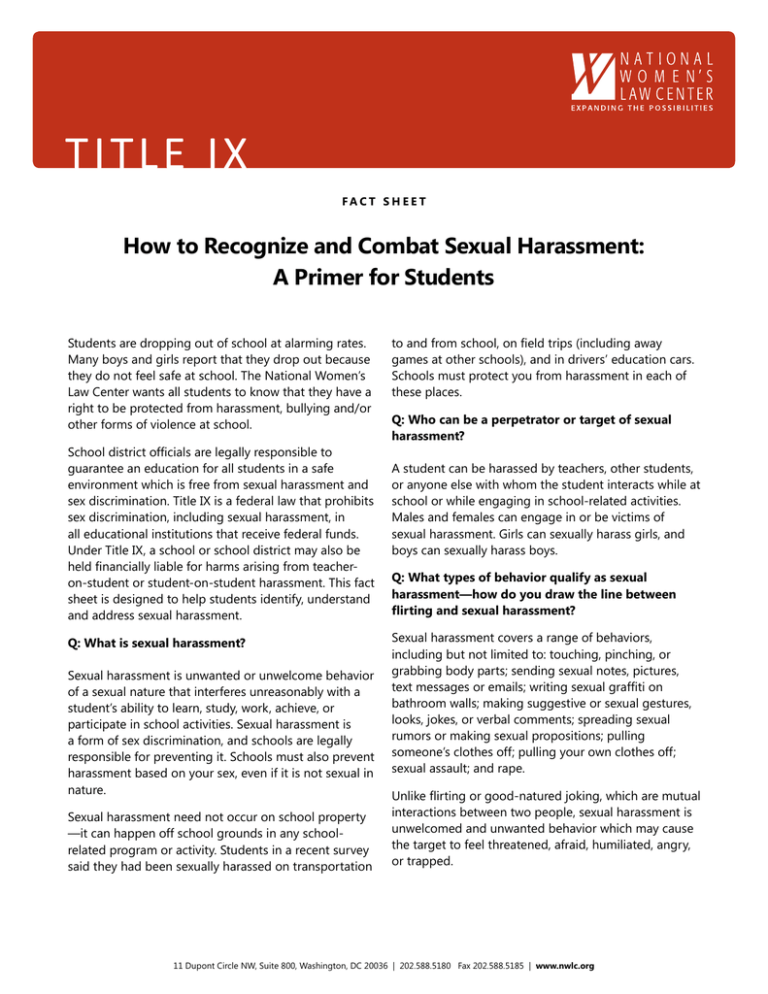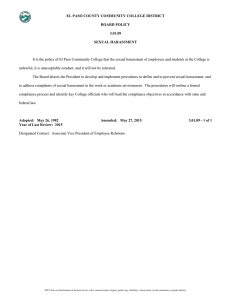
p r o t e c t i n g s u r v i v o r s o f s e x u a l a s s a u l t o n c a m p u s : t a l k i n g p o i n t s • FACT S H EET
T I TL E I X
F ac t sh e e t
How to Recognize and Combat Sexual Harassment:
A Primer for Students
Students are dropping out of school at alarming rates.
Many boys and girls report that they drop out because
they do not feel safe at school. The National Women’s
Law Center wants all students to know that they have a
right to be protected from harassment, bullying and/or
other forms of violence at school.
School district officials are legally responsible to
guarantee an education for all students in a safe
environment which is free from sexual harassment and
sex discrimination. Title IX is a federal law that prohibits
sex discrimination, including sexual harassment, in
all educational institutions that receive federal funds.
Under Title IX, a school or school district may also be
held financially liable for harms arising from teacheron-student or student-on-student harassment. This fact
sheet is designed to help students identify, understand
and address sexual harassment.
Q: What is sexual harassment?
Sexual harassment is unwanted or unwelcome behavior
of a sexual nature that interferes unreasonably with a
student’s ability to learn, study, work, achieve, or
participate in school activities. Sexual harassment is
a form of sex discrimination, and schools are legally
responsible for preventing it. Schools must also prevent
harassment based on your sex, even if it is not sexual in
nature.
Sexual harassment need not occur on school property
—it can happen off school grounds in any schoolrelated program or activity. Students in a recent survey
said they had been sexually harassed on transportation
to and from school, on field trips (including away
games at other schools), and in drivers’ education cars.
Schools must protect you from harassment in each of
these places.
Q: Who can be a perpetrator or target of sexual
harassment?
A student can be harassed by teachers, other students,
or anyone else with whom the student interacts while at
school or while engaging in school-related activities.
Males and females can engage in or be victims of
sexual harassment. Girls can sexually harass girls, and
boys can sexually harass boys.
Q: What types of behavior qualify as sexual
harassment—how do you draw the line between
flirting and sexual harassment?
Sexual harassment covers a range of behaviors,
including but not limited to: touching, pinching, or
grabbing body parts; sending sexual notes, pictures,
text messages or emails; writing sexual graffiti on
bathroom walls; making suggestive or sexual gestures,
looks, jokes, or verbal comments; spreading sexual
rumors or making sexual propositions; pulling
someone’s clothes off; pulling your own clothes off;
sexual assault; and rape.
Unlike flirting or good-natured joking, which are mutual
interactions between two people, sexual harassment is
unwelcomed and unwanted behavior which may cause
the target to feel threatened, afraid, humiliated, angry,
or trapped.
11 Dupont Circle NW, Suite 800, Washington, DC 20036 | 202.588.5180 Fax 202.588.5185 | www.nwlc.org
p r o t e c t i n g s u r v i v o r s o f s e x u a l a s s a u l t o n c a m p u s : t a l k i n g p o i n t s • FACT S H EET
Q: If a girl wears tight clothing or a short skirt, is
she asking to be sexually harassed?
Sometime people like to dress stylishly and attractively,
but that does not mean that they want to attract
everyone or that they are looking to be sexually
harassed. Harassment is unwanted and can make a
person feel trapped, confused, helpless, embarrassed or
scared—certainly no one is asking for those feelings.
Blaming the victim makes being bullied seem like
something we can control with our clothing or physical
characteristics—but the reality is that women and girls
are sexually harassed regardless of their appearance,
age, race, or class.
Q: Who is responsible if a student is harassed at
school?
Schools have a duty to prevent harassment, to have
policies against it, to investigate complaints, and to
take prompt action to stop harassment when it occurs.
In some cases, a student may be able to go to court to
get damages, if a school fails in these responsibilities.
Although an individual harasser cannot be sued under
Title IX, if the harasser has engaged in a criminal act—
like rape, attempted rape, or assault—then a district
attorney may choose to prosecute the individual in
criminal court.
Q: What should I do if I am being sexually harassed?
Sexual harassment which is ignored often escalates. If
you feel safe doing so, let the harasser know that his
or her attention is unwanted and alert other people—a
friend, a counselor, or trusted adult—about the
behavior. Doing so protects your rights and the rights
of other students to be free from this unwanted
behavior. Here are some basic things you should do if
you believe you are being sexually harassed:
• Tell the harasser that you want the unwelcome
behavior to stop. If you feel comfortable doing so, tell
the harasser that his or her behavior bothers you and
that you want it to stop.
• Talk to someone you trust. Whether it’s a friend,
parent, counselor, or someone else whom you trust,
find a person who believes you. Doing this will
provide you with support and can be important
evidence later.
• Keep a detailed written record of the harassment.
Record what happened, when, where, who else
was present, and how you reacted. Save any notes,
pictures, or other documents you receive from the
harasser.
• Report the harassment. Refer to your school’s antiharassment policy and talk to the Title IX Coordinator.
If you feel uncomfortable talking to the designated
person, go to a teacher or another adult at the school
whom you like and trust. It’s okay to bring a friend or
parent with you to that meeting.
• File a complaint. You have the right to file a complaint
with the U.S. Department of Education’s Office for
Civil Rights, with your state’s Department of
Education, or to bring a lawsuit under Title IX. You
may want to talk to a lawyer about these options,
particularly if you are thinking of filing a lawsuit.
• Remember you are not alone. The most recent
comprehensive study of sexual harassment in high
schools found that 83% of females and 79% of males
reported having been sexually harassed in ways that
interfered with their lives, with 27% experiencing it
often.
Know that you have a right to feel safe in school. If you
have concerns about harassment, bullying, or other
forms of violence, you can seek help. For more
information, contact us at info@nwlc.org.
11 Dupont Circle NW, Suite 800, Washington, DC 20036 | 202.588.5180 Fax 202.588.5185 | www.nwlc.org
p r o t e c t i n g s u r v i v o r s o f s e x u a l a s s a u l t o n c a m p u s : t a l k i n g p o i n t s • FACT S H EET
1
2
3
C
.P. Krebs et al., The Campus Sexual Assault (CSA) Study, Final Report: January 2005 through December 2007, vii (2007), available at https://www.ncjrs.gov/pdffiles1/nij/grants/221153.pdf [hereinafter The Campus Sexual Assault Study].
R
ana Simpson, DOJ Off. of Community Oriented Policing Services, Acquaintance Rape of College Students 4 (2001), available at http://cops.usdoj.gov/pdf/e03021472.pdf.
See, e.g., Simpson v. Univ. of Colo. Boulder, 500 F.3d 1170 (10th Cir. 2007) (after alleged rape, football player assailant was punished through “extra running” and
directed to write a letter of apology); Wills v. Brown, 184 F.3d 20 (1st Cir. 1999) (university recommended that a visiting professor who had sexually assaulted a
11 Dupont Circle NW, Suite 800, Washington, DC 20036 | 202.588.5180 Fax 202.588.5185 | www.nwlc.org
p r o t e c t i n g s u r v i v o r s o f s e x u a l a s s a u l t o n c a m p u s : t a l k i n g p o i n t s • FACT S H EET
4
5
6
7
8
9
10
11
12
13
14
15
16
17
student continue on the faculty for an additional year despite the fact that he had made “mistakes.”); J.K. v. Arizona Board of Regents (Arizona State University
was forced to pay $850,000 in a settlement when student was expelled for rape and then was permitted to return, only to commit another alleged rape).
Presidential Memorandum - Establishing a White House Task Force to Protect Students from Sexual Assault, 79 Fed. Reg. 4383 (Jan. 27, 2014), available at
https://federalregister.gov/a/2014-01645.
White House Task Force to Protect Students from Sexual Assault, Not Alone: The First Report of the White House Task Force to Protect Students from Sexual Assault 7 (April 2014), available at http://www.whitehouse.gov/sites/default/files/docs/report_0.pdf.
Dep’t of Ed., Office of Civil Rights, 2001 Revised Sexual Harassment Guidance, available at http://www2.ed.gov/about/offices/list/ocr/docs/shguide.pdf.
C
.P. Krebs et al., College Women’s Experiences with Physically Forced, Alcohol- or Other Drug-Enabled, and Drug-Facilitated Sexual Assault Before and Since Entering College, 57 J. AM. C. HEALTH 639 (2009).
The Campus Sexual Assault Study at vii.
Amer. Pyschological Assoc., Coerced Sex Not Uncommon for Young Men, Teenage Boys, Study Finds (March 25, 2014), available at http://www.apa.org/news/press/releases/2014/03/coerced-sex.aspx.
C
trs. for Disease Control & Prevention, The National Intimate Partner and Sexual Violence Survey: 2010 Summary Report 18 &19 (Nov. 2011), available at http://www.cdc.gov/violenceprevention/pdf/nisvs_report2010-a.pdf.
Walt Bogdanich, A Star Player Accused, and a Flawed Rape Investigation, N.Y. Times, April 16, 2014, http://www.nytimes.com/interactive/2014/04/16/sports/errors-in-inquiry-on-rape-allegations-against-fsu-jameis-winston.html.
C
laire Groden, Campus Rape Victims Find a Voice, Time, Aug. 08, 2013, available at http://nation.time.com/2013/08/08/campus-rape-victims-find-a-voice/?iid=tsmodule.
Angie Epifano, An Account of Sexual Assault at Amherst College, The Amherst Student, Oct. 17, 2012, http://amherststudent.amherst.edu/?q=article%2F2012%2F10%2F17%2Faccount-sexual-assault-amherst-college.
T
yler Kingkade, Harvard’s Handling of Sexual Assault Reports Lambasted in Federal Complaint, Huffington Post, April 3, 2014, available at http://www.huffingtonpost.com/2014/04/03/harvard-sexual-assault-complaint_n_5080708.html.
Jason Felch & Jason Song, Occidental College Settles in Sexual Assault Cases, L.A. Times, September 18, 2013 available at http://articles.latimes.com/2013/sep/18/local/la-me-occidental-settlement-20130919.
Simpson v. University of Colorado, 500 F.3d 1170 (10th Cir. 2007)
R
ichard Pérez-Peña & Kate Taylor, Fight Against Sexual Assaults Holds Colleges to Account, N.Y. Times, May 3, 2014, available at http://www.nytimes.com/2014/05/04/us/fight-against-sex-crimes-holds-colleges-to-account.html.
11 Dupont Circle NW, Suite 800, Washington, DC 20036 | 202.588.5180 Fax 202.588.5185 | www.nwlc.org



